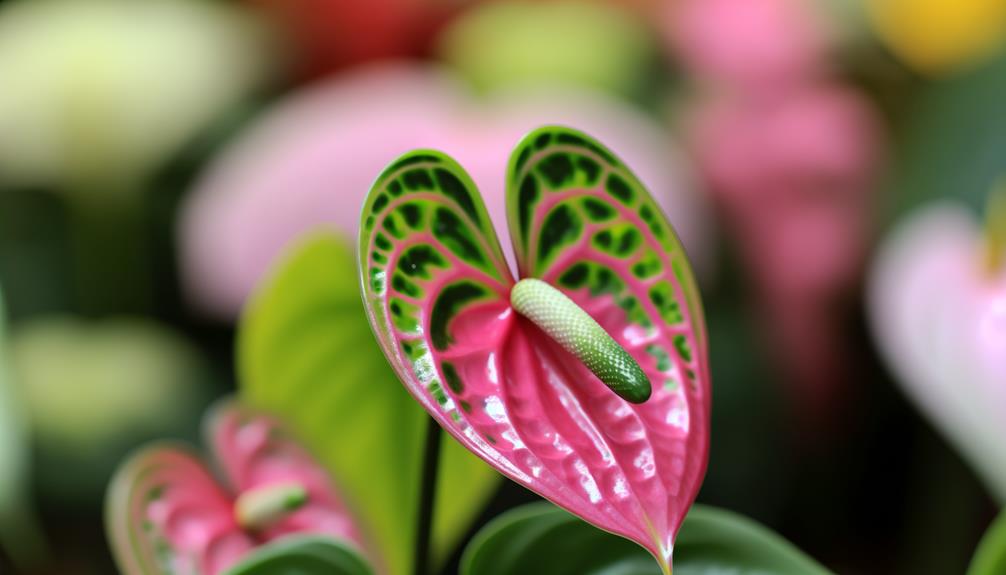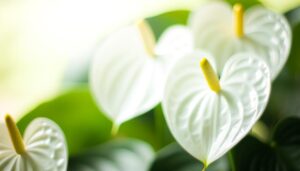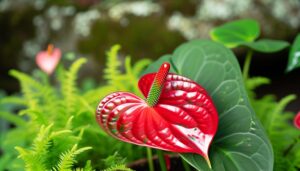Why Is the Anthurium Pink Princess Unique?
The Anthurium Pink Princess stands out due to its striking variegation, featuring vivid pink patches against deep green leaves caused by a genetic mutation. You'll find its care needs quite specific—high humidity, well-draining soil composed of orchid bark, perlite, and peat moss, and bright, indirect light.
Rotation helps even light distribution, while avoiding direct sunlight prevents leaf burn. Cultivation involves precise techniques, especially propagation through stem cuttings, which require consistent soil moisture and high organic matter.
This exotic plant's rarity and fascinating pink variegation make it a coveted choice among collectors. Discovering more about its cultivation can further enhance your enjoyment.

Key Takeaways
- Displays striking pink and green variegation due to a genetic mutation.
- Requires specific high humidity and well-draining soil for optimal growth.
- Rare and exotic, making it highly sought after by collectors.
- Limited global availability due to challenging propagation and care techniques.
- High demand and low supply contribute to its uniqueness and value.
Striking Variegation
The Anthurium Pink Princess displays striking variegation characterized by its vivid pink and green foliage, resulting from a genetic mutation affecting chlorophyll distribution. This mutation creates distinct patches of pink where chlorophyll is absent, contrasting beautifully with the green.
You'll notice that the intensity of pink can vary depending on light exposure. To enhance variegation, provide bright, indirect light. Avoid direct sunlight as it can scorch the leaves. Maintain a humid environment, ideally around 60-80% humidity, and keep the soil consistently moist but not waterlogged. Use a well-draining potting mix rich in organic matter.
Regularly rotate the plant to guarantee even light distribution, promoting balanced growth and more uniform variegation.
Rare and Exotic
You'll find the Anthurium Pink Princess is a rare gem, characterized by its limited global availability and distinctive pink variegation.
With high demand and low supply, acquiring one can be a challenge, requiring meticulous cultivation techniques.
Maintain ideal growth conditions, including high humidity and indirect light, to preserve its exotic appearance.
Limited Global Availability
Due to its meticulous cultivation requirements and slow propagation rate, Anthurium Pink Princess is rarely found outside specialized botanical gardens and select private collections worldwide.
You'll need a controlled environment to nurture this plant, maintaining consistent humidity levels around 70-80% and temperatures between 65-80°F. These conditions mimic its native tropical habitat, ensuring ideal growth.
Regularly monitor the soil, ensuring it stays moist but not waterlogged, as the plant is prone to root rot. Use a well-draining, organic-rich substrate to support its delicate root system.
Propagation is time-consuming; stem cuttings need careful attention and several months to establish roots. Mastering these techniques and conditions is essential, making the Anthurium Pink Princess a rare gem for dedicated enthusiasts.
Distinctive Pink Variegation
Beyond its limited global availability, Anthurium Pink Princess captivates enthusiasts with its distinctive pink variegation, characterized by striking patches of vibrant pink interspersed with deep green foliage. This variegation results from a rare genetic mutation affecting chlorophyll production, creating a breathtaking visual contrast.
You'll find the most favorable results in achieving these vivid hues by providing bright, indirect light, which enhances the pink pigmentation. Consistent humidity, ideally between 60-80%, supports prime growth. Regularly misting the leaves can help maintain this moisture level.
Use a well-draining, peat-based soil mix to prevent root rot. Fertilize monthly with a balanced liquid fertilizer during the growing season to sustain its lush appearance. With attentive care, your Anthurium Pink Princess will thrive, showcasing its exotic charm.
High Demand, Low Supply
The rarity of the Anthurium Pink Princess, coupled with its exotic appeal, has created an intense demand among plant enthusiasts and collectors. You'll find that its variegated foliage, with striking pink sectors, isn't just alluring but also genetically rare.
This scarcity is compounded by slow propagation rates, making each specimen a prized possession. Cultivation requires a fine balance of humidity, indirect light, and well-draining soil to maintain its unique coloration.
You need to monitor nutrient levels closely, ensuring a rich supply of phosphorus to promote vibrant pink hues. The meticulous care required makes the Anthurium Pink Princess even more desirable, as it symbolizes both rarity and dedication.
Owning one isn't just a hobby; it's a demonstration of your botanical prowess.
Unique Leaf Texture
Anthurium Pink Princess displays a distinct leaf texture marked by its velvety surface and intricate vein patterns, making it a remarkable specimen in any botanical collection. You'll notice the leaves' unique tactile quality, a result of microscopic trichomes that give them a soft, almost suede-like feel.
The deep green foliage, enhanced with pink variegation, isn't just visually stunning but also indicative of the plant's health.
To maintain this exquisite texture, make sure you provide high humidity levels, ideally between 60-80%. Mist the leaves regularly but avoid waterlogging. Use a well-draining soil mix rich in organic matter.
Position the plant in bright, indirect light to prevent leaf burn while promoting vibrant variegation. Your careful attention will reward you with lush, textured leaves.
Fascinating Growth Patterns
With its intriguing growth patterns, the Anthurium Pink Princess develops new leaves that initially unfurl in a captivating spiral, gradually revealing their vibrant pink variegation and unique texture.
As you observe, you'll notice the leaves' chlorophyll distribution, which creates the striking contrast between pink and green. Each leaf emerges with a glossy surface, showcasing intricate venation and delicate, undulating edges.
When cultivating your Anthurium, make sure it receives bright, indirect light to maintain its stunning coloration. The plant thrives in well-draining, aerated soil, which supports its extensive root system.
Regularly rotate the plant to encourage even growth and symmetrical leaf development. By maintaining ideal humidity levels, you'll promote faster leaf expansion and enhance the plant's overall health and beauty.
Specific Care Needs
Ensuring your Anthurium Pink Princess thrives involves maintaining ideal conditions such as proper watering techniques, precise humidity levels, and appropriate fertilization schedules.
To achieve optimal growth, focus on the following care needs:
- Watering: Use distilled or rainwater to keep the soil consistently moist but not waterlogged. Overwatering can lead to root rot.
- Humidity: Maintain humidity levels between 60-80%. Use a humidifier, or place the plant on a pebble tray with water to create a humid microenvironment.
- Light: Provide bright, indirect light. Direct sunlight can scorch the leaves, while low light reduces vibrant coloration.
- Fertilization: Apply a balanced, water-soluble fertilizer every 4-6 weeks during the growing season to support healthy foliage and root development.
Air-Purifying Qualities
Your Anthurium Pink Princess offers significant air-purifying benefits, absorbing harmful chemicals like formaldehyde and ammonia from your indoor environment. Its broad, glossy leaves increase the surface area for efficient absorption of volatile organic compounds (VOCs).
To maximize this, position your plant in indirect sunlight to boost photosynthesis, which enhances its detoxifying capabilities.
Ensure the soil remains moist but not waterlogged; well-draining potting mix is ideal. Regular misting raises humidity, aiding stomatal function for better gas exchange. Trim dead or yellowing leaves promptly to maintain peak health.
Historical Background
Tracing the roots of the Anthurium Pink Princess, this enchanting plant boasts a rich history that intertwines with the tropical rainforests of Central and South America. Your fascination deepens when you learn its vibrant pink variegation results from selective breeding and genetic mutations.
To truly appreciate its journey, consider:
- Origin: Native to the humid, shaded understory of rainforests.
- Discovery: Identified by botanists in the mid-20th century.
- Cultivation: Enhanced through greenhouse practices to amplify its unique coloration.
- Popularity: Gained prominence in the 21st century as a coveted houseplant.
Understanding these points, you grasp why its lush foliage and striking hues captivate plant enthusiasts. This historical backdrop enriches your appreciation, making the Anthurium Pink Princess a living tribute to botanical artistry.
Propagation Techniques
You'll start propagating your Anthurium Pink Princess by employing the stem cutting method, which requires sharp, sterilized pruning shears.
Make sure the cuttings have at least one node and a few leaves before placing them in well-draining soil with high organic matter.
Maintain soil moisture consistently, but avoid waterlogging to promote healthy root development.
Stem Cutting Method
Taking a stem cutting from the Anthurium Pink Princess for propagation involves selecting a healthy, mature stem with at least two nodes and a few leaves.
To propagate successfully:
- Cut the Stem: Use a sterilized knife or scissors to make a clean cut just below a node.
- Prepare the Cutting: Remove any lower leaves, leaving a few at the top to encourage photosynthesis.
- Apply Rooting Hormone: Dip the cut end into rooting hormone to stimulate root growth.
- Plant the Cutting: Place the cutting in a well-aerated growing medium, like perlite or sphagnum moss.
Make sure the cutting has high humidity and indirect light.
Soil and Water Requirements
Proper soil and water management are pivotal to successful propagation of your Anthurium Pink Princess. You'll want a well-draining mix, combining equal parts orchid bark, perlite, and peat moss. This guarantees aeration and prevents root rot.
Watering requires a delicate balance; keep the soil consistently moist but never waterlogged. Use room-temperature, filtered water to avoid chlorine damage. Mist the leaves occasionally to maintain humidity levels around 60-80%.
During propagation, make sure cuttings are placed in a humid environment, such as a greenhouse or covered with a plastic bag. Check moisture levels regularly and adjust as needed. This meticulous care will foster robust root development and vibrant foliage in your Anthurium Pink Princess.
Common Challenges
Caring for an Anthurium Pink Princess often presents several challenges. Managing humidity levels, preventing root rot, and ensuring adequate light exposure are crucial for its well-being. You'll need to be vigilant and precise with your care to keep this unique plant thriving.
Here are four essential steps:
- Humidity: Maintain 60-80% humidity using a humidifier or pebble tray.
- Watering: Water only when the top inch of soil is dry to avoid waterlogging and root rot.
- Light: Provide bright, indirect light to prevent leaf scorching and promote variegation.
- Soil: Use well-draining, airy soil mixed with perlite and orchid bark.
Collectors' Appeal
The Anthurium Pink Princess captivates collectors with its striking variegated foliage, which showcases a unique blend of vibrant pink and deep green hues. You'll find its chlorophyll-deficient sectors fascinating, as they contribute to its rare coloration.
To maintain its vivid appearance, make sure it receives indirect sunlight and a well-draining potting mix rich in organic matter. Humidity levels should hover around 60-80%, mimicking its native tropical environment. Regularly misting the leaves and using a humidity tray can enhance its growth.
Pruning is important to encourage new variegated growth. When propagating, select cuttings with visible pink variegation. It's essential to monitor for pests like spider mites, which can mar its beauty. Your attentive care will keep this botanical treasure thriving.
Conclusion
To conclude, the Anthurium Pink Princess is a botanical gem, enchanting plant enthusiasts with its striking variegation and unique leaf texture. Its rare, exotic nature demands specific care, making it a prized jewel in any collection.
Picture caring for this plant like tending to a living masterpiece—each leaf a stroke of nature's palette. Grasping its growth patterns, propagation techniques, and common challenges will guarantee your Pink Princess flourishes, enhancing your cultivation skills to a higher standard.






